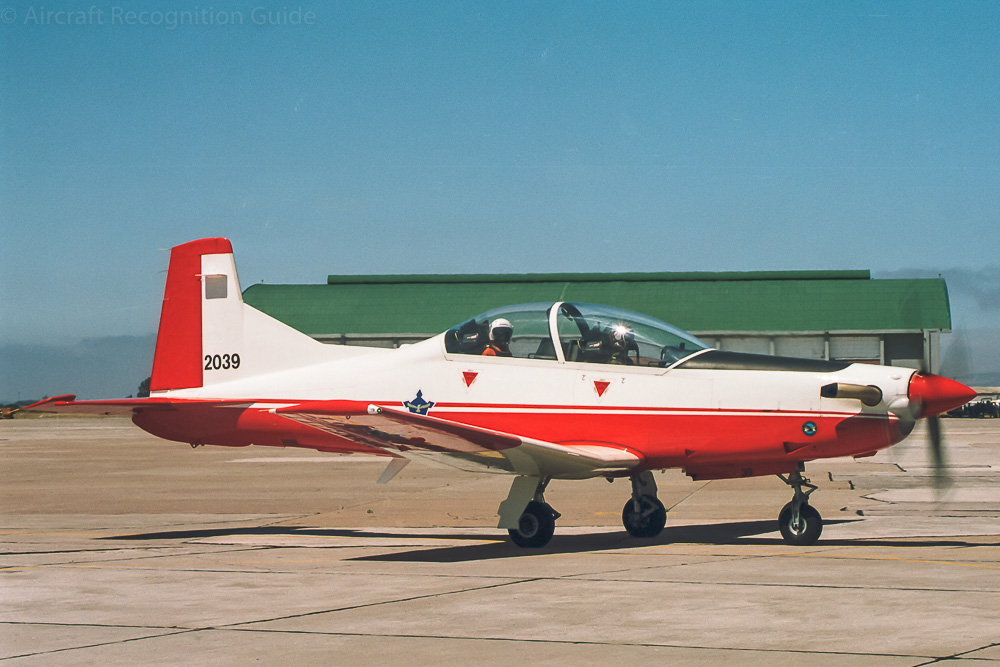
TAI Hürkuş
Even though there were already many different high performance turboprop training aircraft, Turkey decided to design and build its own. Taking the Korean KAI KT-1 Woong Bee as starting point Turkish Aerospace Industries made the Hürkuş.
The looks of the Hürkuş is similar to other aircraft in this category. It has straight low wings mated to a slender fuselage with a cockpit in which the instructor pilot sits higher than the student pilot. The canopy has two parts, separated by a bow frame behind the front seat, but open sideways in a single piece. The fuselage appears to be shorther than its competitors, giving it a stubby look. At the rear is a vetical stabiliser with a large dorsal fin, that looks like that of the PC-7 MkII/PC-9M. Below the tail is a ventral fin. The wings have a continuous dihedral. The PT6 engine up front powers a five blade propeller.
Different versions
The different versions of the PC-9 can be recognised by:
- the presence of winglets
- the presence of a small dent in the dorsal fin
- the presence of a head-up display (HUD)
- the presence of storage points under the wings
Hürkuş-A
TAI first made a civil version that was eventually certificated under civil rules. In appearance it lacks the small winglets and dent in the dorsal fin that the other two variants have.
The Hürkuş-A is characterised by the absence of small winglets. (photo: Bulent KAVAKKORU/WikiMedia)
Hürkuş-B
This is the basic training version for the Turkish air force. Compared to the A model it has small, triangular winglets and a head-up display, that may be visible from the outside. Finally, it has a small dent in the dorsal fin
The Hürkuş version for the Turkish air force is the Hürkuş-B. As you can see it has small winglets. (photo: WikiMedia/Anna Zvereva)
Hürkuş-C
Like many competitors the Hürkuş has a light attack version, called the Hürkuş-C. It is essentially a Hürkuş-B with storage points for weapons under the wings. A full view photo is at the top of the page.
A detail view of a Hürkuş-C tail, with its larger dorsal fin with a small dent in the middle. Also the winglet is clearly visible.
Confusion possible with
Pilatus PC-7 MkII/PC-9M
The most tricky recognition is between the Hürkuş and the PC-7 MkII/PC-9M. Both have a very similar tail. The PC-7 and PC-9 have inner wings with no dihedral, whereas the Hürkuş has ones with continuous dihedral. Other differences are much more subtle.
PZL130 Orlik
The PZL130 has many characteristics of the Hürkuş. If you look well you see that the leading edge of the fin is more an S shape than on the Turkish trainer. Also the air intake is more separated from the prop spinner.
KAI KT-1 Woong-Bee

This Korean aircraft also resembles the Hürkuş, in particular the nose, canopy and wings. However, the KT-1 has a much smaller dorsal fin, no ventral fin, a four blade prop and the nose gear doors are shorter. (photo: Alto Bidini/WikiMedia)
Pilatus PC-21
The successor of the PC-9 has a two piece canopy much similar to that of the Hürkuş, and also wings with constant (small) dihedral and long nose landing gear doors. Different are the shark-like top of vertical stabiliser and smaller dorsal fin.
Calidus B-250

Another look-a-like is this trainer/light fighter. The canopy has two bow frames and the prop four blades, enough to avoid a mix-up with the Hürkuş. The nose gear is quite close to the prop, but not as much as on the Tucano. (photo: Mztourist/WikiMedia)
Beech T-6 Texan II
Being derived from the Pilatus PC-9 it is logical that it share a lot of similarities with the Texan II. So the main differences with the Hürkuş are similar: the dorsal fin of the T-6 is much smaller and canopy has two bow frame compared to one on the TAI aircraft.
Embraer (Super) Tucano
The Super Tucano has a similar canopy as the T-6 Texan II, so with three parts. All Tucano's have a nose gear that is close to the prop, much closer than the other aircraft mentioned here.










